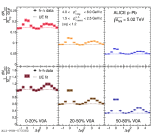Figures from paper submitted to Physical Review C
Abstract:
First measurements of hadron(h)$-\Lambda$ azimuthal angular correlations in p$-$Pb collisions at $\sqrt{s_{\rm NN}}$ = 5.02 TeV using the ALICE detector at the Large Hadron Collider are presented. These correlations are used to separate the production of associated $\Lambda$ baryons into three different kinematic regions, namely those produced in the direction of the trigger particle (near-side), those produced in the opposite direction (away-side), and those whose production is uncorrelated with the jet axis (underlying event). The per-trigger associated $\Lambda$ yields in these regions are extracted, along with the near- and away-side azimuthal peak widths, and the results are studied as a function of associated particle $p_{\rm T}$ and event multiplicity. Comparisons with the DPMJET event generator and previous measurements of the $\phi(1020)$ meson are also made. The final results indicate that strangeness production in the highest multiplicity p$-$Pb collisions is enhanced relative to low multiplicity collisions in both the jet-like regions and the underlying event. The production of $\Lambda$ relative to charged hadrons is also enhanced in the underlying event when compared to the jet-like regions. Additionally, the results hint that strange quark production in the away-side of the jet is modified by soft interactions with the underlying event.
Phys. Rev. C 111 (2025) 015201
e-Print: arXiv:2405.19855 | PDF | inSPIRE











